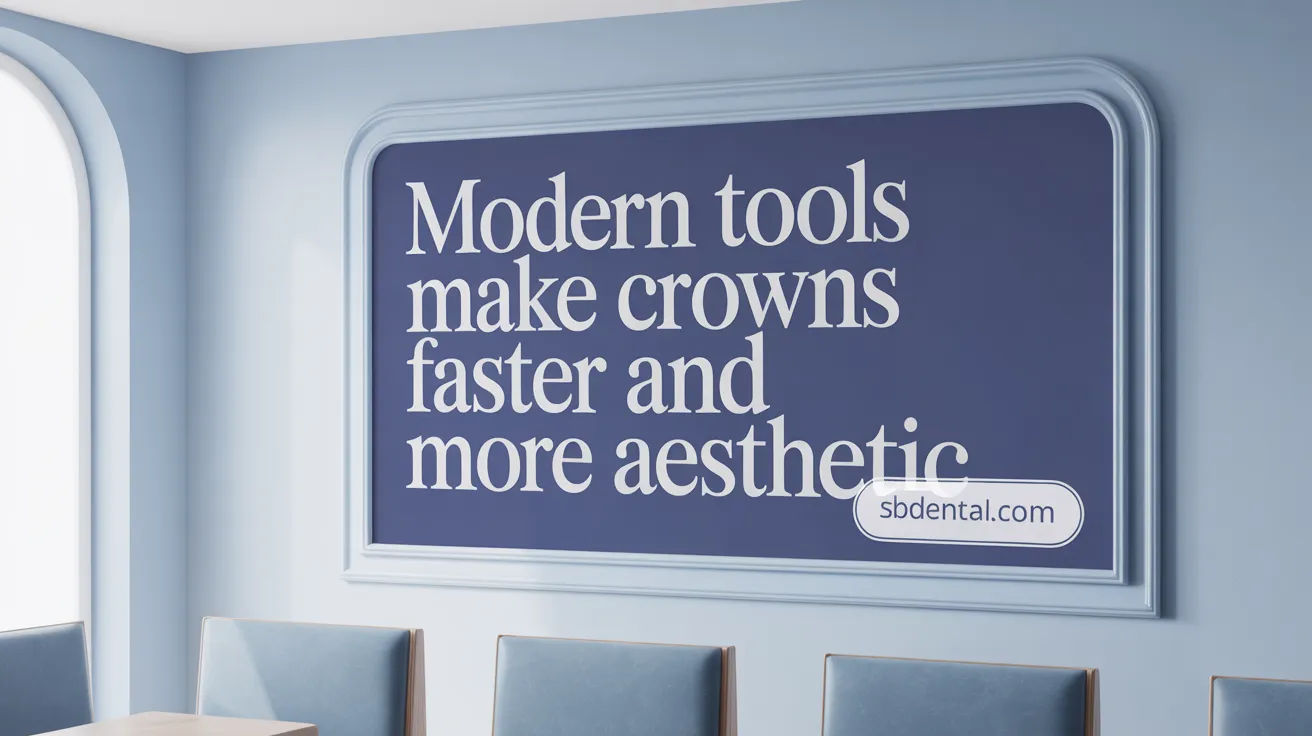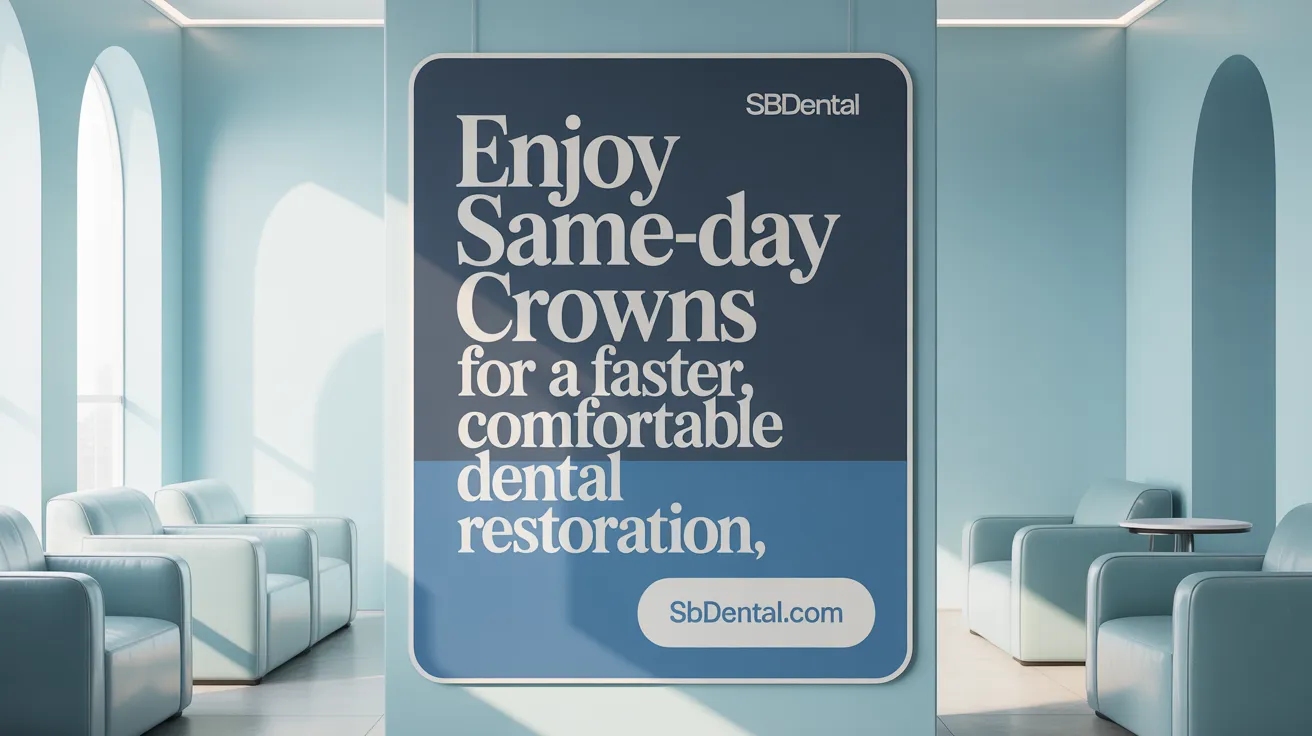Introducing Same-Day Crowns: A Breakthrough in Restorative Dentistry
In modern dentistry, innovations continually improve patient convenience and outcomes. Among these advances, same-day crowns stand out for their ability to streamline the dental crown procedure, compress treatment into a single visit, and significantly enhance speed and efficiency. This article explores the technology behind same-day crowns, compares them with traditional options, and highlights the impact of digital workflows on patient care and treatment success.
Understanding Dental Crown Procedures and the Role of Modern Technology

Overview of dental crown procedure steps
A dental crown procedure typically involves several important steps to restore a damaged or decayed tooth. First, the dentist examines and prepares the tooth, removing any decayed or damaged tissue. Next, impressions of the tooth are taken—traditionally using molds, but increasingly through digital scanning. If using modern technology, digital impressions are captured swiftly and comfortably with intraoral cameras, offering greater precision.
Once the impression is collected, the crown is designed using computer-aided design (CAD) software. In traditional settings, the impression is sent to a dental laboratory where the crown is crafted over a few weeks. However, with in-office digital technology, such as CEREC, the crown can be fabricated immediately using CAD/CAM systems, enabling the placement of a same-day crown.
The final step is the milling or manufacturing of the crown from ceramic or other materials, then fitting and bonding it onto the prepared tooth. This approach reduces the number of visits needed, providing patients with faster and more accurate results.
Use of digital scanning and CAD/CAM technology
Modern dental practices leverage digital scanning and CAD/CAM technology to enhance the crown fabrication process. Digital impressions eliminate messy traditional molds, enhance patient comfort, and increase accuracy, capturing detailed 3D images of the tooth and surrounding structures.
CAD/CAM software allows dentists to carefully design the crown, ensuring it fits precisely, matches natural tooth color, and restores proper function. The design is then sent to an in-office milling machine, which carves the crown from a solid ceramic block usually within 15-20 minutes. This digital workflow enables the entire process—from preparation to cementation—to be completed in a single visit.
Materials used for crowns and their selection
Crowns can be made from various materials, including porcelain, zirconia, ceramic, gold, or metal alloys. Material choice depends on multiple factors such as the location of the tooth, aesthetic needs, bite forces, and patient preferences. Ceramic and zirconia crowns are favored for front teeth due to their natural appearance, while metals are preferred for molars for their strength.
With modern technology, same-day crowns are often fabricated from high-quality ceramic materials, providing a good balance of strength, durability, and aesthetics. Choice of material impacts the longevity of the crown, with ceramic options lasting typically between 10 and 15 years with proper care.
Impact of technology on treatment time and outcomes
Advancements in digital technology have revolutionized dental crown procedures by significantly reducing treatment time and improving outcomes. Traditional crowns require two or more visits, with a wait period for laboratory fabrication. In contrast, CAD/CAM and digital impressions streamline the process, allowing patients to receive their permanent crown in just one appointment.
This approach not only saves time but also results in better-fitting crowns, reduced discomfort—especially by eliminating temporary crowns—and aesthetically pleasing restorations that closely match natural teeth. Additionally, the digital precision minimizes adjustments and enhances overall durability.
Longevity and care of dental crowns
While the average lifespan of a crown ranges from 5 to 15 years, proper care can extend its durability. Maintaining good oral hygiene—including brushing, flossing, and regular dental check-ups—is essential. Avoiding hard and sticky foods can prevent fractures or dislodgement.
With advances in materials and technology, especially with ceramic and zirconia crowns, longevity has improved. Proper care, combined with the precision of modern procedures, helps ensure that crowns remain functional and attractive for many years.
| Aspect | Traditional Crowns | Modern Digital Crowns | Remarks |
|---|---|---|---|
| Fabrication Time | Weeks (Conventional crowns) | Same day (Same-day crowns) | Digital technology reduces treatment time |
| Material Options | Wide (metal, porcelain, ceramics) (Dental crown materials) | Mainly ceramics (High-quality ceramic crowns) | Material choice impacts longevity |
| Fit & Precision | Excellent (laboratory standard) (Traditional crowns precision) | Very good (digital precision) (CAD/CAM precision) | Digital scans increase accuracy |
| Patient Comfort | Moderate (impressions, temp crowns) (Temporary crowns drawbacks) | High (digital impressions, fewer visits) (Comfort of same-day crowns) | Technology improves comfort |
| Longevity | 5-15 years (Traditional crown longevity) | 10-15 years or more (Ceramic crowns durability) | Material and care-dependent |
How Same-Day Crowns Work: Technology and Procedure Explained
How do same-day crowns work, and what technology is used in the procedure (e.g., CEREC technology, CAD/CAM)?
Same-day crowns, also known as CEREC crowns, utilize cutting-edge digital technology that allows dentists to design, produce, and place a dental crown in a single visit. The process begins with digital scanning of the damaged tooth using an intraoral camera, which captures a precise 3D image of the tooth and surrounding structures. This digital impression replaces traditional messy molds, providing a more comfortable experience for the patient.
Once the scan is complete, the dentist uses specialized CAD (Computer-Aided Design) software to meticulously design the crown, ensuring a perfect fit and natural appearance. The software allows for real-time adjustments, giving the dentist complete control over the crown’s shape, size, and color to match adjacent teeth seamlessly.
After the design is finalized, it is transferred to an in-office milling machine. This machine carves the crown from a block of durable ceramic material, typically within about 20 minutes. The ceramic is chosen for its strength, longevity, and aesthetic qualities, closely resembling natural tooth enamel.
The final step involves bonding the fabricated crown directly onto the prepared tooth during the same appointment. This entire process, from digital scan to placement, generally takes around 1-2 hours. This technology—CEREC (Chairside Economical Restoration of Esthetic Ceramics)—along with CAD/CAM systems, allows for fast, precise, and highly aesthetic dental restorations without the need for temporary crowns or multiple visits.
Comparison of CEREC and alternative technologies
While CEREC is the most widely recognized system, other technologies such as E4D or Planmeca’s PlanCAD Easy offer similar digital crown fabrication solutions. These alternatives also employ digital scanning and milling, although the specific hardware and software may vary. Regardless of the system used, the core advantage remains the ability to provide same-day, high-quality crowns, improving patient experience and efficiency.
Benefits of Same-Day Crowns: Convenience, Speed, and Efficiency
 Same-day crowns offer numerous advantages that make them highly appealing to patients seeking efficient dental restorations. One of the most significant benefits is the ability to complete the entire treatment in a single appointment. Using advanced CAD/CAM crown design technology such as CEREC technology, dentists can design and craft the crown on-site, which usually takes about 1 to 2 hours. This rapid process eliminates the need for multiple visits, saving patients considerable time.
Same-day crowns offer numerous advantages that make them highly appealing to patients seeking efficient dental restorations. One of the most significant benefits is the ability to complete the entire treatment in a single appointment. Using advanced CAD/CAM crown design technology such as CEREC technology, dentists can design and craft the crown on-site, which usually takes about 1 to 2 hours. This rapid process eliminates the need for multiple visits, saving patients considerable time.
Another key advantage is the elimination of temporary crowns. Traditional crowns often require a temporary cover, which can cause discomfort, sensitivity, and a risk of dislodgement. Since same-day crowns are fabricated and placed in the same visit, patients avoid these issues altogether, leading to greater comfort.
The reduction in chair time and appointment frequency also translates into cost savings. By bypassing laboratory fabrication, patients often incur fewer expenses related to multiple visits and temporary protections. The digital impressions vs traditional impressions process used in same-day crowns is less invasive and more comfortable than traditional molds, contributing further to patient satisfaction.
While they provide impressive convenience, speed, and a precise fit, it’s worth noting that in some cases, especially with complex or heavy-load teeth, conventional dental crowns may still be preferred for their durability and customizable options. Nonetheless, for many routine cases, same-day crowns significantly improve the overall dental experience, combining efficiency with quality.
Comparing Same-Day and Traditional Crowns: Pros, Cons, and Suitability

How do same-day crowns compare to traditional dental crowns?
Same-day crowns are created and placed within a single appointment thanks to advanced digital technology like CAD/CAM systems. Unlike traditional crowns, which take several weeks to produce in a dental lab across multiple visits, same-day crowns offer instant results. Traditional crowns involve measuring, impression-taking with materials, and multiple visits including a temporary crown period. They are generally more precise and durable because they are handcrafted in a lab using a wider array of materials such as porcelain-fused-to-metal or gold, making them suitable for teeth facing heavy biting forces or requiring long-term durability.
In contrast, same-day crowns are predominantly made from ceramic materials, which are aesthetically pleasing but may have slight limitations in strength and thickness. They involve less removal of natural tooth structure because the digital process is highly accurate, but they might be less suitable for complex or heavily stressed areas. Overall, each approach has advantages tailored to specific patient needs, balancing convenience with longevity.
Material options and durability considerations
Traditional crowns offer a broad selection of materials, including gold, porcelain-fused-to-metal, and pressed or all-ceramic options. This variety allows dentists to recommend the most suitable material based on the tooth’s location, function, and aesthetic needs. These crowns typically last between 10 to 15 years or longer, especially the metal types, due to their strength.
Same-day crowns are mainly made from high-quality ceramic or porcelain, which provides a good match for natural teeth and resists staining. While the ceramic used in CEREC crowns is durable, it may not be as resistant as metal or zirconia crowns, especially in areas of high bite pressure like molars. The longevity of same-day crowns generally ranges from 5 to 10 years, although with proper care, some can last longer.
Precision and fit variations
Lab-made traditional crowns tend to have a slight edge in fit accuracy because skilled technicians craft them based on detailed impressions, including full-mouth scans. This meticulous craftsmanship can translate into a better internal fit and overall longevity.
On the other hand, digital impressions and in-office milling for same-day crowns produce highly precise but slightly less detailed fits, especially when fractures extend below the gum line or involve complex anatomy. Nonetheless, technological advances continually improve the fit and durability of same-day crowns, making them a highly viable option for many cases.
Suitability based on tooth location and condition
Ideally, traditional crowns are preferred for complex cases involving extensive damage, fractures below the gumline, or areas subjected to significant biting pressure, like molars. Their superior strength and customization make them ideal for load-bearing zones.
Same-day crowns are well-suited for straightforward restorations, such as front teeth or well-contained fractures, where aesthetic appearance and quick results are priorities. They are also recommended for patients needing swift treatment due to busy schedules or emergency situations.
Factors influencing patient choice and dental recommendations
Deciding between same-day and traditional crowns depends on multiple factors. Patient preferences regarding convenience, speed, and aesthetics play a significant role. Some may prioritize the durability and extensive material options of traditional crowns, especially for back teeth.
The dentist’s clinical judgment based on the tooth's condition, location, and the patient’s occlusion and habits will guide the optimal choice. Budget considerations, insurance coverage, and long-term longevity concerns are also important. Ultimately, a thorough evaluation by a dental professional helps ensure the selected crown type aligns with the patient’s oral health needs and lifestyle.
| Aspect | Traditional Crowns | Same-Day Crowns | Additional Notes |
|---|---|---|---|
| Fabrication Time | Several weeks | 1-2 hours | Multiple visits vs. single appointment (Same-day crowns process) |
| Material Options | Wide variety including metals and porcelain | Mainly ceramic | Durability and aesthetics vary (Dental crown materials) |
| Fit and Precision | Very high with lab customization | Highly accurate with digital tech | Slight differences in complex cases (Precision fit dental crowns) |
| Suitability | Complex, load-bearing, extensive damage | Mild to moderate, aesthetic cases | Based on tooth condition and needs (Choosing between same-day and traditional crowns) |
| Costs | $800–$3,000 | $1,000–$1,500 | Varies with material and location (Cost comparison of crowns) |
| Durability | 10-15 years or more | 5-10 years | Proper care extends lifespan (Durability of crowns) |
| Ideal Use | Heavy chewing areas, complex fractures | Front teeth, straightforward cases | Clinical judgment needed (Factors in choosing dental crowns) |
This overview highlights that both crown types have their places in modern dentistry, with the choice tailored to individual needs, tooth conditions, and patient preferences. Consulting with a skilled dentist ensures the best approach for each unique case.
Impact of Digital Technology on Crown Fabrication and Patient Outcomes
 The advent of digital technology for crowns has profoundly transformed the way dental crowns are designed and manufactured, leading to improved patient outcomes and more efficient treatment processes.
The advent of digital technology for crowns has profoundly transformed the way dental crowns are designed and manufactured, leading to improved patient outcomes and more efficient treatment processes.
One of the most significant advancements is the use of digital scanning and 3D imaging. Intraoral scanners capture highly accurate impressions of teeth, replacing traditional mold materials that can be uncomfortable for patients. This digital capture results in precise models that enhance the fit of crowns, minimizing adjustments and improving the overall aesthetic and function.
CAD/CAM (Computer-Aided Design and Manufacturing) software is central to modern crown fabrication. It allows dentists to customize crowns more accurately, ensuring a better internal and external fit. This software's precision helps produce crowns that blend seamlessly with natural teeth, boosting patient satisfaction and oral health.
In-office milling machines take these digital designs and carve crowns directly from ceramic or porcelain blocks. These high-speed milling devices can produce restorations within 15-20 minutes, often completing the entire process during a single appointment. Advanced multi-axis mills improve the accuracy and strength of the crowns while reducing material waste.
Patients benefit from this technological synergy through shorter treatment times and increased comfort. The elimination of temporary crowns and traditional impressions reduces discomfort and possibility of misfit or bacterial entry. As technology continues to evolve, so too do long-term outcomes, with newer materials and refined processes promising durable, highly aesthetic crowns.
Overall, digital workflows have made crown fabrication more predictable, faster, and tailored to individual needs, contributing to better oral health, higher patient satisfaction, and continued innovation in restorative dentistry.
The Future of Dental Restorations: Embracing Same-Day Crown Technology
Same-day crowns represent a transformative shift in restorative dentistry, blending speed, precision, and patient-centered care. By leveraging advanced digital scanning and CAD/CAM technology, dental professionals can provide high-quality, natural-looking crowns in a single visit, significantly enhancing convenience and comfort. While traditional crowns still hold advantages in durability and material variety for complex cases, same-day crowns offer an efficient alternative for many patients seeking timely and reliable treatment. As technology continues to evolve, the integration of digital workflows promises to further improve treatment outcomes and patient satisfaction across dental practices worldwide.
